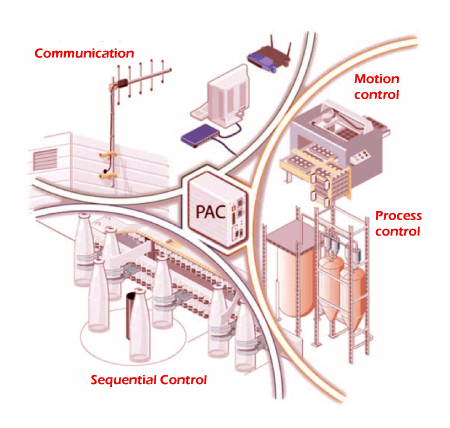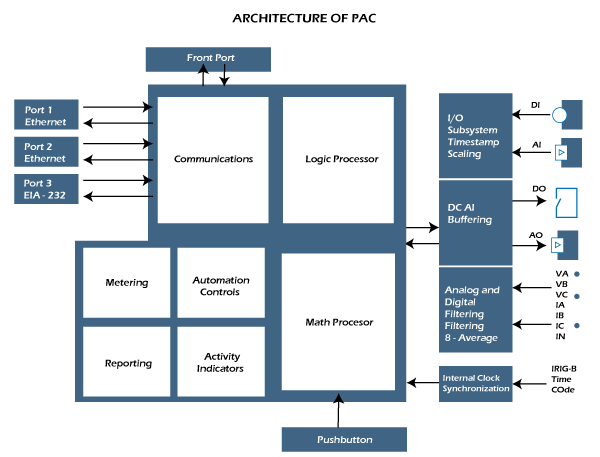What is PAC?
Programmable Automation Controller is a programmable microprocessor-based device used for discrete manufacturing, process control, and remote monitoring applications. These computers are the brains of a manufacturing operation as they control automation equipment with high reliability.
PACs combine programmable logic controller (PLC) functions with the greater flexibility of a PC. They are also more easily set up for data collection and integration with their business applications than PLCs.
PLCs and PACs are very similar to each other as they both perform the same essential functions and modern technology. For example, all automated systems are built with a PLC or PAC to control each machine or station.

The term PAC is accepted as having been coined by the ARC Advisory Group, which specified five characteristics that define a PAC:
- Multi-domain functionality
- A single, multi-discipline development platform
- Flexible software tools that maximize process flow across machines or processes
- An open, modular architecture
- Compatibility with enterprise networks
ARC coined the term for two reasons first is to help automation hardware users better define their application needs, and second is to give automation hardware vendors a term to more clearly communicate the capabilities of their products.
Although each PAC vendor uses its development environment (IDE) and programming language, PAC networking is typically based on IP and Ethernet.
PAC Categories
Programmable automation controllers are divided into these two categories:
- PAC systems: A PAC system consists of one or more PAC modules, each performing a specific function.
- PAC modules: PAC modules are add-on devices that perform a specific control function in PAC systems. Common types of PAC modules include analog I/O modules, digital I/O modules, relay modules, counter modules, serial modules, servo or stepper controller modules, timer modules, and data acquisition modules.
Many programmable automation controllers include watchdog timers, real-clock timers, visual indicators, reset buttons, or surge protection. PACs with an integral power supply or built-in web server are also available. Hot-swappable PACs can be installed or uninstalled during regular operation.
Characteristics of PAC
A PAC as having the following characteristics, such as:
- Operates using a single platform in multiple domains, including logic, motion, drives, and process control. Because a single PAC can make all types of control, monitoring, data acquisition, system expansion, and change simplified.
- Employs a single development platform using common tagging and a single database for development tasks across various disciplines. The same software is used for all development; this IDE (Integrated development environment) reduces development time.
- Tightly integrates controller hardware and software: When hardware and software are designed together, systems are easier and faster to build. In addition, some PAC manufacturers, such as Opto 22, include surprisingly capable software with a PAC purchase.
- Programmable using software toolscapable of designing control programs to support a process that "flows" across several machines or units, integrating multiple domains into a single system.
- Operates on open, modular architectures that mirror industry applications, from machine layouts in factories to unit operation process plants. Since each installation is different, the system must be able to add or change modules easily.
- Employs de-facto standardsfor network interfaces, languages, and protocols, allowing data exchange as part of networked multi-vendor systems.
- Provides efficient processing and I/O scanning:A PAC's first duties are efficient monitoring, control, and data acquisition. Traditional continuous scanning, for example, is often less efficient than exception-based scanning performed only when control logic dictates.
Architecture of PAC
Programmable Automation Controllers (PAC) is designed with user-friendly hardware and software architecture which are easier to operate by IT Programmers.

The ability of PACs to gather, store, and track large amounts of data means they can handle predictive maintenance and operations monitoring.
- Data is often stored and accesses through an Ethernet network or a USB storage device.
- PACs use the IEC 61131-3 programming languages (ladder diagram, function block diagram, sequential function chart, instruction list, or structured text), and some include standard PC programming languages such as C/C++, so familiarity is retained, and the learning curve for programming is low, regardless of prior experience or expertise.
- Programming is done in an integrated development environment (IDE) that uses a single, tag-name database. It means that all the defined variables (tags) are kept in one database used by all the software applications, such as HMIs, ERP systems, and vision applications. Thus, it simplifies and reduces programming work and makes it easier to scale to larger systems.
Communication Standards and Network Protocols
Programmable automation controller (PAC) systems use popular communication standards and network protocols. For example, Ethernet is a local area network (LAN) protocol that supports data transfer rates of 10 Mbps.
- Transmission control protocol/Internet protocol (TCP/IP) is the basis for standard Internet protocols.
- Controller area network bus (CANbus) is a high-speed, serial data network designed for harsh electrical environments and real-time control applications.
- DeviceNet uses the CAN network protocol to connect industrial devices to PAC modules. Fieldbus or PROFIBUS(Profibus International) is an open-communication standard used in factory automation, process automation, motion control, and safety applications.
- The MODBUS (Modbus-IDA) protocol is an open-standard, vendor-neutral messaging structure for communication between intelligent devices.
- OPC defines a set of standard interfaces based upon OLE/COM technology and can be reused by the human-machine interface (HMI) and supervisory control and data acquisition (SCADA) applications.
- Java (Sun Microsystems, Inc.) database connectivity (JDBC) allows PAC modules to access external structured query language (SQL) databases.
Features of PAC Module
A programmable automation controller (PAC) module has the following attractive features:
- It includes watchdog timers, real-clock timers, visual indicators, and surge protection.
- PAC modules with a reset button, integral power supply, and built-in web server are also available.
- Hot-swappable PAC modules can be installed or uninstalled when the PAC system is running.
- Programmable automation controller (PAC) modules for international markets should comply with Restriction of Hazardous Substances (RoHS), a European Union (EU) directive that requires all manufacturers of electronic and electrical equipment sold in Europe to demonstrate that their products contain only minimal levels of hazardous substances such as lead and mercury.
- The EU's Waste Electrical and Electronic Equipment Regulations (WEEE Regulations) are designed to encourage the reuse, recycling, and recovery of electrical and electronic equipment such as PAC modules.
Advantages of PAC
These defining characteristics also describe the key advantages of using PACs in industrial applications:
- A single controller with integrated software handles multiple functionsacross multiple domains.
- Modular designsmake expansion easier.
- Networking and communication capabilitieslink disparate systems and provide more accurate and timely data.
- Total system cost is lowered because integrated hardware and software are less expensive because development and integration time are reduced.
- Modular designimproves cash flow.
- Extensive analog control capabilities.
- PACs tend to be smaller in size and more durable.
- Runs in a scheduled cyclic mode
How are PACs Different?
PACs differ from the hardware you're probably using now in several ways. In effect, PACs expand the capabilities of hardware you're using now by merging features of more traditional PLC, DCS, and RTU systems, plus adding some capabilities from PCs.
- PLC: Traditional PLC (programmable logic controller) systems provided discrete-logic-based control of input/output (I/O) signals, using ladder logic programming.
- DCS: DCS (Distributed control system) traditionally provided process control, batch control where product variations are made according to recipes, or continuous process control.
- RTU: The traditional remote terminal unit provided multiple communication options for monitoring remote assets, such as radio towers or pipelines.
- PC:PC-based control traditionally linked an adapter card on a computer to I/O, with custom applications written for control and communication.
Difference between PAC and PLC
Programmable Logic Controllers (PLCs) and Programmable Automation Controllers (PACs) are the most efficient industrial computer devices developed and designed to assist and make manufacturing operations easier. These controllers are considered the brains of the manufacturing process as they efficiently control automation equipment with high reliability.
PLCs and PACs are more similar to each other as both are powered by common features and functionality. However, with the interference of modern technology, the capabilities of these devices have changed. PLC's were invented in the late 1960s, whereas PACs are new to the automation industry in controlling machinery coined in 2001.
The main distinguish between PLCs and PACs is their programming language. Below are the following differences between PAC and PLC as per their features, functions, and capabilities, such as:
|
PAC |
PLC |
| Processor Module |
Programmable Automation Controller (PAC) is a multiprocessor device built with two or more processors like any other personal computer.
PACs are equipped with multitasking capabilities to control the automation of various pieces of equipment. |
A programmable Logic Controller (PLC) is a single microprocessor device used to control manufacturing, infrastructure, transportation, and machine or station control automation equipment. |
| Architecture |
Programmable Automation Controllers are designed with user-friendly hardware and software architecture which are easier to operate by IT Programmers. |
Programmable Logic Controllers were designed to replace the relay-based systems.
The engineers used to represent physical reply sans timers with the help of ladder logic diagrams in PLCs for programming the sequence of events and reactions I/O devices. |
| Usage |
PAC is incorporated with modular design open architecture use for communicating, monitoring, and controlling equipment covering multiple networks and devices. |
PLC has built-in networks which enable them to communicate between multiple PLCs, I/Os, HMIs (human-machine interfaces), and SCADA (supervisory-control and data-acquisition) systems. |
| Memory |
PACs incorporate simplified program expansion operations and have a huge memory size for larger projects and systems. With this feature, the addition and elimination of components become easier.
In addition to providing tag-based programming, PACs can also monitor and control plenty of I/O points. |
PLCs comprise high-level program execution speed but have limited memory and separate I/O device.
All the new advanced PLCs can control high-speed Input/output, sequence, and Proportional-Integral-Derivative (PID) besides digital and analog I/O. |
| Programming Language |
PACs use the IEC 61131-3 programming languages (ladder diagram, function block diagram, sequential function chart, instruction list, or structured text). In addition, some include standard PC programming languages such as C or C++, etc. |
Programmable Logic Controllers uses Ladder Logic Diagram Programming, and |
| Reliability |
Programmable Automation Controllers permit tag naming, giving users a chance to characterize and define the data categories as they program.
Thus, providing a more excellent adaptability feature, particularly while extending the framework. |
Programmable Logic Controllers have a fixed memory map and address depending on their programming capability. |
| Features |
Programmable Automation Controllers are built-in with more features such as Data USB ports, a high-quality LCD screen for a better user interface, and a web server for seeing system data log files. |
And advanced Programmable Logic Controllers come with good control communication and data handling options. |
| Communication |
PACs utilize standard protocols and network technologies like Ethernet, OLE for Process Control (OPC), and Structured Query Language (SQL) for multitasking operations. |
PLC is mainly used for smaller automation projects and other simple operations which do not need quick scalability. |
| Applications |
Programmable Automation Controllers are ideal for large-scale automation projects and operations.
As the architecture of PAC is enabled with various PC-based software programs, it helps them handle complex automation systems. |
Programmable Logic Controllers are the perfect model for high-speed and straightforward machinery controlling.
They are operated in various applications such as automated spray equipment, assembly equipment, dispensing systems, and motion control systems, to name a few. |
|


 For Videos Join Our Youtube Channel: Join Now
For Videos Join Our Youtube Channel: Join Now









